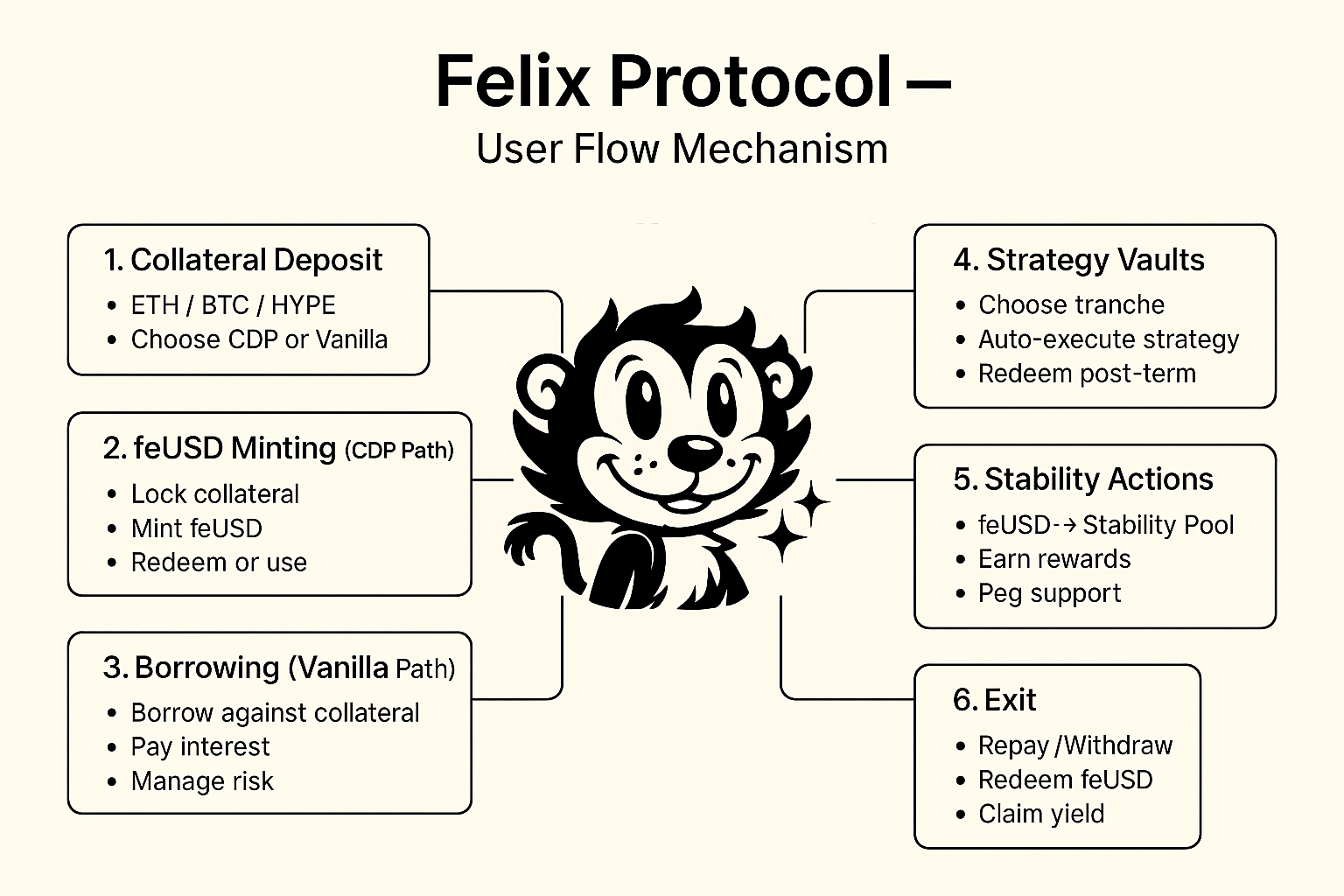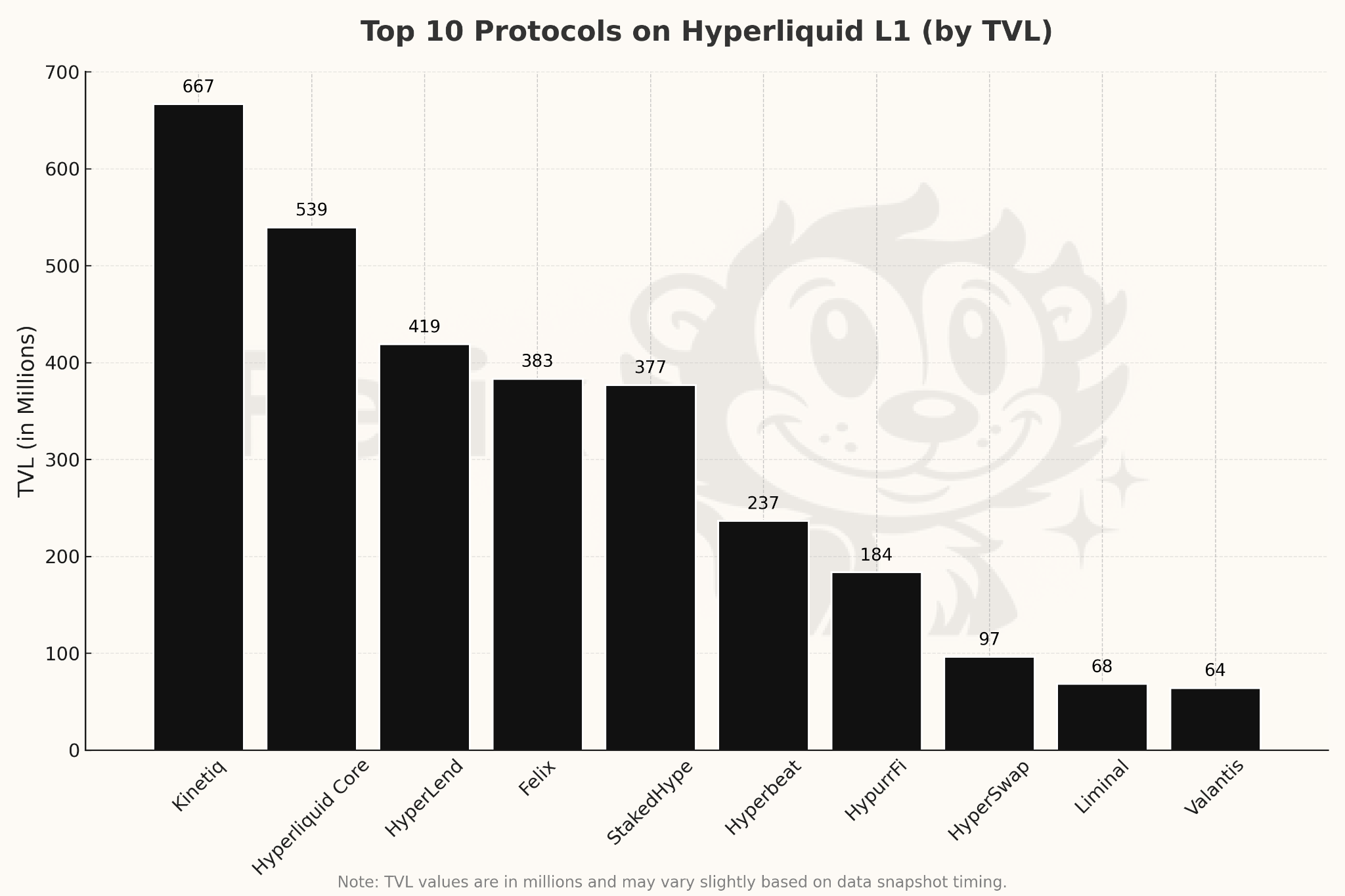.jpg)
Felix: Modular Leverage Built on Hyperliquid

Felix is a modular leverage protocol built natively on Hyperliquid, designed to give users structured access to leverage, capital efficiency, and stablecoin-powered borrowing. As Charlie, co-founder of Felix, puts it, “Users have optionality on Felix, both on the supply side and borrow side, which is a bit unprecedented in an ecosystem as early as HyperEVM.” It lets users engage in composable trading strategies across collateralized debt positions (CDPs), tranching vaults, and traditional borrow-lend interfaces. Instead of layering complexity through synthetic assets or layered abstractions, Felix keeps its architecture minimal and composable with deterministic execution on HyperCore and integrations across the broader Hyperliquid ecosystem.
Built natively on Hyperliquid, designed to give users structured access to leverage, capital efficiency, and stablecoin-powered borrowing. It lets users engage in composable trading strategies across collateralized debt positions (CDPs), tranching vaults, and traditional borrow-lend interfaces. Instead of layering complexity through synthetic assets or layered abstractions, Felix keeps its architecture minimal and composable with deterministic execution on HyperCore and integrations across the broader Hyperliquid ecosystem.
The protocol supports feUSD, a native overcollateralized stablecoin backed by onchain CDPs. It enables leverage and directional exposure through Felix CDP, Felix Vanilla, and automated vaults with minimal reliance on oracles or external debt markets. Users interact with Felix via strategy vaults, interest-bearing lending, and redemption markets all executed trustlessly onchain.
Founders and Protocol Origins
Felix was co-founded by Charlie, a risk-focused builder who entered crypto through Bitcoin and developed a deep interest in DeFi mechanics during the 2021 cycle. After working in banking and venture capital and earning a degree in philosophy, Charlie launched Anthias Labs in 2022 to build liquidation health monitoring tools for lending protocols. That work gave way to the foundational architecture of Felix.
Backed by Hyperliquid’s HyperActive syndicate and launched in close collaboration with the Connect team, Felix was developed with a user-first mindset. Charlie emphasized the importance of speaking directly with users, not just theorizing in a vacuum. That philosophy is reflected in Felix’s clear UX flows, point-based incentive systems, and transparent execution logic. From its inception, Felix has focused on delivering onchain leverage tools with the modularity and composability needed to scale.
Core Mechanism: Strategy Vaults and Deterministic Execution
At the center of Felix’s design is its strategy vault system. These vaults are permissionless smart contracts that automate execution, define leverage tranches, and settle capital according to predefined rules. Users deposit into vaults split by risk-return preference, and vaults execute trades directly on HyperCore with no offchain steps or oracle dependencies.
Execution occurs through Felix’s integration with Hyperliquid’s CoreWriter. Batch instructions are posted to worker validators, and execution receipts are returned with deterministic state updates. Vaults operate on a rolling or fixed cadence, automating long/short strategies, rebalancing events, or position rollovers. Because everything happens on Hyperliquid’s native block engine, execution is final, parallelized, and observable.

Onchain Composability and Protocol Integrations
Felix is deeply integrated into Hyperliquid’s DeFi stack. It connects with Kinetiq to route validator rewards and staked assets like kHYPE into vault positions. It works with USDhl for stablecoin settlement, borrowing legs, or synthetic replication. Felix also leverages HypurrFi for undercollateralized access and margin overlays.
These aren’t just surface integrations. Builders can directly invoke Kinetiq yield flows into vault parameters or settle feUSD into USDhl at strategy maturity. This makes Felix’s vault logic extensible across Hyperliquid’s primitives. It enables structured products to be as lean or complex as needed from simple directional exposure to synthetic credit tranching. The Felix Trade interface even supports basic spot liquidity routing.
feUSD Stability, Collateral Strategy, and Peg Reinforcement
Felix’s feUSD system is powered by overcollateralized debt positions. Users mint feUSD by depositing ETH, BTC, HYPE, and other approved collateral. Vault health is maintained by a system of Stability Pools and redemptions, with liquidation bots incentivized to keep collateral ratios safe.
A key stability feature is the redemption mechanism, any user can exchange 1 feUSD for $1 worth of collateral, helping reinforce the peg. Stability Pools let feUSD holders park capital and absorb liquidations, earning yield in the process. Additionally, Felix Vanilla allows users to obtain leverage without minting feUSD. This creates a parallel path for accessing capital, further reducing peg stress.
The team is also exploring a Peg Stability Module (PSM) involving USDhl similar to MakerDAO’s USDC module that would allow feUSD to maintain a stable off-ramp via trusted assets. This combination of tools makes feUSD one of the most robust LST-backed stablecoins on Hyperliquid.
Governance and Protocol Controls
Felix does not use a governance token with emissions. Instead, key parameters like mint caps, collateral types, and vault limits are managed by administrator privileges. These powers enable rapid iteration during early-stage development, with plans for progressive decentralization as the system hardens.
Admin privileges include the ability to pause vaults, modify LTV ratios, and approve new asset pairs. While these controls enable agility, they also introduce centralization risks, which the team acknowledges. The roadmap includes community oversight and governance paths that will gradually reduce reliance on admin-controlled upgrades.
Audits and Protocol Criticisms
Felix is built on the Liquity V2 codebase, which has undergone audits from ChainSecurity, Dedaub, Recon, Coinspect, and formal verification from Certora. The Liquity architecture forms the basis of Felix’s CDP engine and has proven to be robust under stress testing.
Felix-specific modifications include three custom enhancements: mint caps to limit system-wide leverage, trove parameter controls for admin responsiveness, and a global pause feature to manage tail risk. These changes are under separate audit by Dedaub and Coinspect to ensure safety in production.
Despite the strong audit heritage, certain risks remain. Centralized control via admin privileges can delay response or introduce configuration errors. Contracts are still upgradeable, making them less censorship-resistant until governance is fully decentralized. Additionally, ecosystem-level concerns include evolving oracle feeds, slippage from non-atomic orderbook liquidations, and thinner liquidity on newer collateral types like HYPE and kHYPE.
Protocol Activity and Product Traction
Felix has deployed over 22 vaults across markets including ETH, BTC, SOL, and HYPE. Daily trade volumes exceed $7 million, and total value locked across CDP, Vanilla, and vaults now surpasses $ 383 million. This makes Felix one of the largest protocols on Hyperliquid by TVL.
Its vault system supports diverse strategies. From leverage-max ETH long vaults to range-bound SOL hedging structures, Felix enables DeFi users to access structured products previously limited to centralized venues. Vault creators configure everything from rollover frequency to tranching logic, and Felix manages trade execution, tracking, and settlement seamlessly.

Why Felix Protocol Matters
Felix brings structured financial logic to Hyperliquid without sacrificing simplicity or composability. In doing so, it expands the definition of what leverage protocols can offer. Its vault engine, native stablecoin system, and integrations across the validator-backed infrastructure give users and builders powerful primitives all aligned with deterministic, gas-efficient execution. By delivering these capabilities within Hyperliquid's unique validator framework, Felix ensures real-time throughput, permissionless deployment, and composable execution for developers seeking performance without compromise.
Felix’s footprint in the ecosystem continues to grow meaningfully. It currently secures nearly $ 383 million in total value locked (TVL). It generates approximately $15.8 million in annualized fees, or around $60,000 per day, a figure that underscores the protocol’s healthy user adoption and trading activity. These earnings aren’t retained by the protocol. Instead, they are redistributed through Stability Pools, interest repayments, and incentives, creating a circular economy of yield and participation. Felix’s design represents a shift toward user-first revenue models that favor reinvestment over extraction
Roughly 60 percent of all borrowing occurs via the CDP structure, while 40 percent flows through the more traditional Felix Vanilla lending market, a breakdown that illustrates the protocol's balanced utility across structured and open borrowing formats. This hybrid model gives Felix unique surface area to serve both sophisticated users creating leveraged vaults and everyday users seeking transparent lending with stable returns. Whether you're building on the margins of DeFi innovation or simply parking assets in a secure lending vault, Felix offers tailored, high-performance tools with modular flexibility.
By removing reliance on external oracles, abstract tokens, and permissioned vault launches, Felix sets a new benchmark for transparency and accessibility in DeFi. It operates in real time, encourages collaboration through integration points like HypurrFi and Kinetiq, and supports a full range of user profiles from conservative lenders to high-risk leverage traders. The protocol isn’t just scaling Hyperliquid’s utility. It is actively redefining how financial primitives are built, distributed, and iterated in a fully onchain environment.
